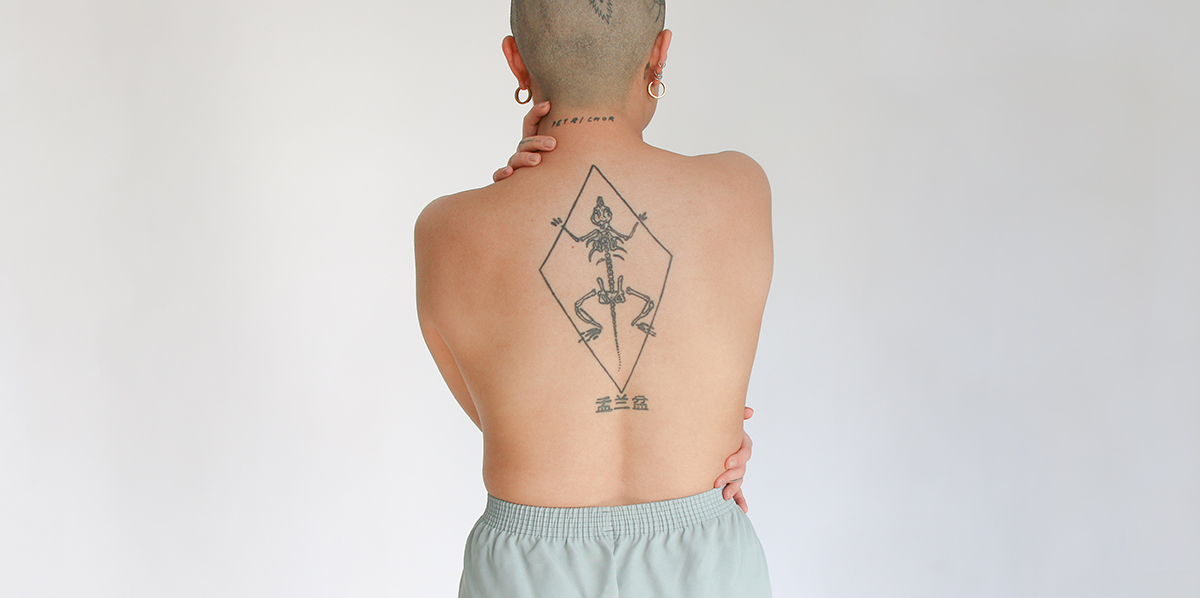So, after careful consideration, maybe a little soul-searching, even, you’ve decided to get a back tattoo. Congrats! Next up, you’ll need to educate yourself on some precautions and prep before hopping onto a tattoo artist’s table. Ahead, here’s everything you need to know about the experiences before, during, and after getting a tattoo on your back.
1. Keep any medical issues front of mind
Before you even considering getting a back tattoo, keep any doctor-related issues front of mind. Specifically, if there’s any possibility of needing surgery in the region, it’s not a wise placement choice. “People with back or spine problems that potentially require surgery should be wary of getting a tattoo on their back, especially their lower back,” says Neil Tanna, MD, Associate Program Director of Plastic Surgery and Professor of Surgery at Northwell Health. Any procedure that would require making an incision for spine surgery makes getting inked on the back a risky decision, he says.
Another reason to skip a new back piece? Pregnancy. “The process of placing an epidural catheter during childbirth could potentially cause tattoo ink to enter spinal components or increase the risk of infection,” explains Tanna.
2. Be aware of the potential pain factors
Your back may be a bit more prone to pain, especially if you’re contemplating the pain or infection factor of getting inked on, say, the back versus am arm. “Different areas of the body have differing levels of sensation; the back may be more sensitive during the tattoo process when compared to other areas,” Tanna says, although there aren’t any specific issues to be mindful of long-term.
Within the back though, that sentiment changes. “In terms of pain, some spots, like the love handle area and upper back towards the neck, can be more sensitive than, say, the shoulder blades area,” says Jay Cunliffe, tattoo artist and owner of Bonedaddys Tattoo and Chief Tattoo Officer for the Philadelphia Union soccer team.
3. Remember that you won’t be able to watch the actual process
Keep in mind that you won’t be able to see the inking in action when getting a back tattoo—for better or for worse. “Some people also like the fact that while getting tattooed, if the client can see the tattoo getting done—they say it hurts less,” Cunliffe explains. “But this is also a personal preference as I’ve also heard that watching it get done hurts more as well!”
From a tattoo artist’s perspective, it’s a fairly easy area to apply ink, per Cunliffe. “Other areas, like the elbow or upper triceps area, have a different type of skin and it can be a more difficult area to saturate the skin [with ink],” he explains.
4. Eat a good meal beforehand—and drink plenty of water, too
Once you’ve picked the ideal spot and design for your back tattoo, what should you do to prep for your tattoo appointment? Prior to getting a tattoo—anywhere, not solely on the back—it’s important to make sure you eat beforehand and are hydrated, Cunliffe recommends. “Don’t drink excessive alcohol the night before, which can cause a lot of bleeding during the tattoo process,” he says, suggesting clients ideally abstain from booze for a couple days prior to getting new ink. Also be sure to avoid sun exposure (yes, that includes tanning beds, which are never a good idea anyway) before a tattoo appointment.
5. Keep an eye out for any infection
There are three essential aftercare musts after getting inked from a medical perspective, regardless of whether the tat is on your back or another part of the body, according to Tanna. “Watch for signs of an infection, ensure proper wound care by regularly having ointment applied, and avoid activities that can expose the tattoo to sources of infection, such as swimming pools,” he advises.
Because, bottom line, “there should be no cause of infection as long as the client takes proper care of the tattoo when done and during the healing process,” Cunliffe says.
6. Use protection—SPF, that is
It’s paramount to ensure that fresh tattoos have the proper sun protection, so have some SPF on hand (these are our favorite dermatologist-recommended picks) to slather religiously on the tattoo if it’s in an area that could get any exposure to rays, especially after getting a tattoo on your back.
7. Invest in aftercare products such as ointment
“Make sure the tattoo is properly moisturized during healing, and try not to scratch it during healing—that can cause any small scans that have formed to rip off and loss of pigment where the scab was lifted off,” Cunliffe advises when it comes to aftercare and getting a tattoo on your back. If possible, figure out a designated post-tattoo helper—a significant other, roommate, or kind pal—who can assist with keeping a back tat properly moisturized and treated, especially if the ink is located somewhere you can’t fully get to on your own. “It also helps to have someone apply aftercare product to your back if you can’t reach a freshly tattooed area,” Cuniffe explains. “Just make sure whoever is helping apply the ointment that their hands are cleaned before applying.”
8. Sleep may not come easily
However, some fresh ink on the back might impact your slumber position for a couple weeks: “Getting a back tattoo means that you will have to sleep on your belly or side while it heals,” Tanna explains. But, while a love handle or neck-adjacent inking session may have a higher ouch factor than other parts of the back, per Cunliffe, there shouldn’t be any long-term problems distinct to where you’ve chosen to get inked. “Once the tattoo heals, there is very little difference” when it comes to tattoo placement, Tanna explains.
Related: How Much Does a Back Tattoo Cost?

